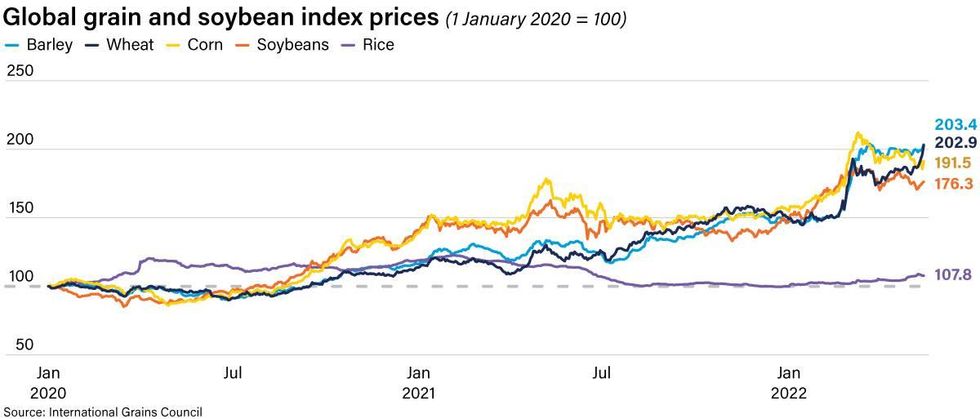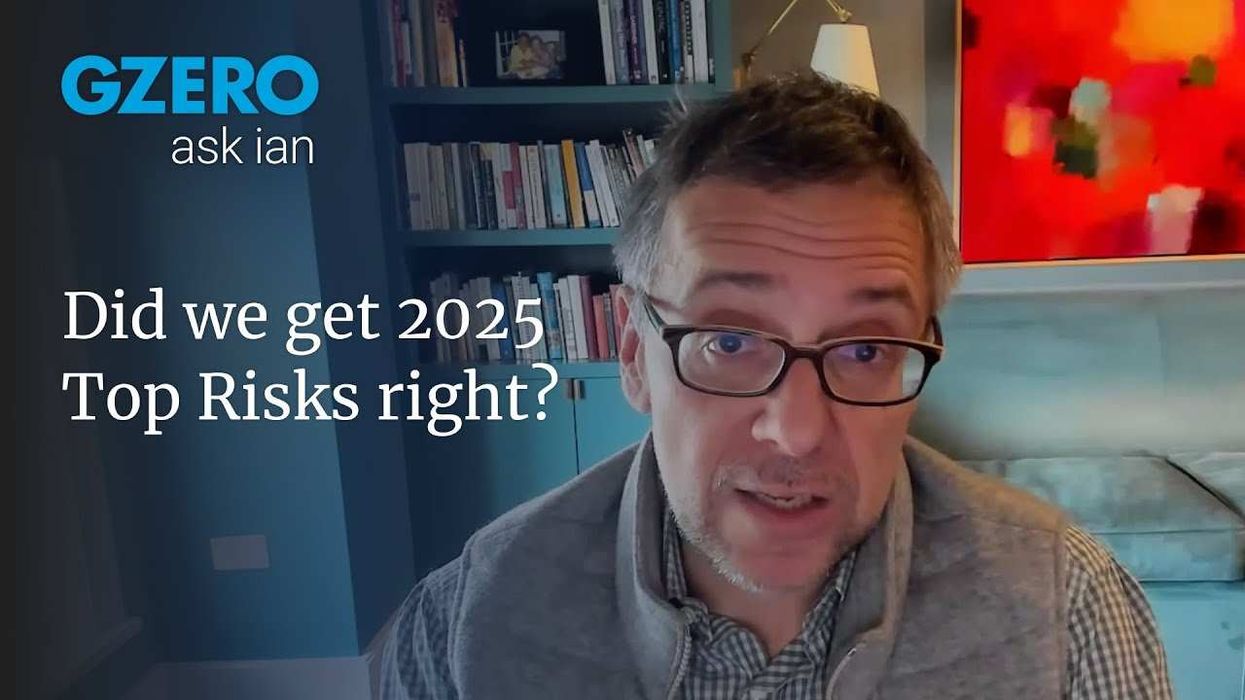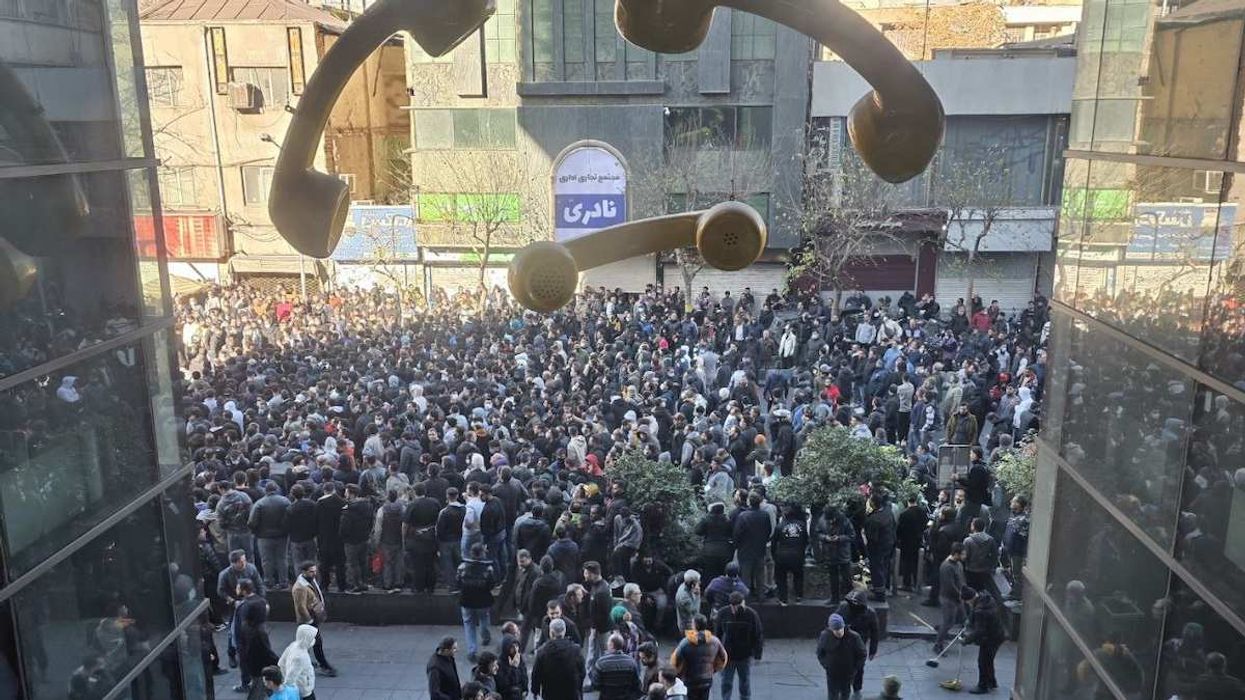The war in Ukraine has been dominating headlines since Russia’s unprovoked invasion on February 24. Of all the implications of the conflict, the most important is also one of the least well-covered: its impact on global food systems.
Three months in, the war has jolted agricultural markets, leading to soaring food prices and growing global hunger. The FAO’s Cereal Price Index was up 21% between January and April, while the Vegetable Oils Index was up 28% in the same period. Before the war started, there were nearly 1.2 billion people globally facing food insecurity, of which 780 million lived in extreme poverty and almost 39 million were at risk of famine. Fast forward to today, and the ranks of people facing food-related distress have swelled to 1.6 billion, 1.1 billion, and 49 million, respectively.
Want to understand the world a little better? Subscribe to GZERO Daily by Ian Bremmer for free and get new posts delivered to your inbox every week.
 Number of people facing food-related distressGro Intelligence
Number of people facing food-related distressGro Intelligence
This is a humanitarian disaster much larger than anything the world has experienced in modern times. And with no end in sight to the war in Ukraine, the crisis isn’t going away. In fact, it’s going to get worse.
According to a recent study conducted by Eurasia Group and DevryBV Sustainable Strategies, food insecurity will affect up to 1.9 billion people (nearly one-quarter of the world population) by November 2022. The report, titled Food Security and the Coming Storm, estimates that over the next five months the war will plunge more than 280 million people into food insecurity, 200 million into extreme poverty, and 7 million to the edge of famine.
Even before the war, record numbers of people around the world were facing food distress on the back of the Covid-19 pandemic, which disrupted global supply chains and led to high food and energy prices as well as rising poverty and hunger, and extreme weather events linked to climate change, which increasingly threaten agricultural yields in large swathes of the world’s cultivated lands. United Nations Secretary-General Antonio Guterres has warned that these converging crises are unleashing a “hurricane of hunger.”
Scenarios for the war and food distress
Looking ahead, how bad the food crisis gets will depend on what happens in the war between Russia and Ukraine. Eurasia Group, the political risk firm I lead, predicts that over the next three months, the war in Ukraine will devolve into a drawn-out, unstable stalemate with a 70% probability. This scenario entails continued low-level fighting in the south and east of Ukraine, with Russia capturing most of the Donbas and holding onto the land bridge linking it to Crimea, Western sanctions remaining in place, and no prospect of a negotiated settlement or a ceasefire.
We put the odds that the conflict escalates further at 25%, in which case Russia would resume its attacks on northern and western Ukraine as well as Kyiv, prompting a step-change intensification in Western sanctions. Finally, we assign a 5% probability to the prospect of a climbdown, with most of the fighting ending and negotiations eventually leading to at least some sanctions relief.
Based on these scenarios and their likely effects on food prices, the report estimates that over the next five months, the Russia-Ukraine war is very likely (95% odds) to push 142-283 million people globally into food insecurity, 103-201 million into extreme poverty, and 3.5-6.9 million to the edge of famine.
 Scenarios for the war and food distressEurasia Group, Gro Intelligence
Scenarios for the war and food distressEurasia Group, Gro Intelligence
The worst humanitarian outcome comes from Eurasia Group’s basecase scenario rather than from its worst-case scenario, as a stalemate would prolong the uncertainty and disruption for longer than a definite escalation.
In the unlikely scenario of a ceasefire in Ukraine, the number of people facing food insecurity would fall by only about 123 million, while those in extreme poverty and facing famine would drop by 95 million and 2.7 million, respectively. This is evidence of just how much food distress is already baked in due to pandemic-related disruptions, climate change, and other factors unrelated to the Russia-Ukraine war.
Transmission channels
There are several ways in which the Russia-Ukraine war disrupts global food security.
First, through reduced food exports from Russia and Ukraine, which before the war jointly contributed 30% of global wheat exports, 32% of barley exports, 17% of corn exports, and nearly 80% of sunflower oil exports. Together, these two countries alone supply 12% of the world’s traded calories.
 Share of global Grains and Oilseed ExportsGlobal Grains Council
Share of global Grains and Oilseed ExportsGlobal Grains Council
Fighting in eastern and southern Ukraine has severely damaged Ukraine’s agricultural production capacity, and the Russian navy’s blockade of Ukraine’s Black Sea ports prevents the export of most of the foodstuffs Ukraine is able to produce, anyway. David Beasley, the head of the UN World Food Program, described Russia’s blockade as an open “declaration of war” on global food security. Meanwhile, Western sanctions and Russian countersanctions inhibit food and fertilizer exports from Russia and Belarus, and hoarding and preemptive protectionist measures such as export restrictions by some food producers (notably, India is curtailing wheat and sugar exports, and Indonesia has banned palm oil shipments) further exacerbate the supply crunch and put upward pressure on prices.
Second, through reduced fertilizer exports from Russia and Belarus, two of the world’s largest fertilizer exporters. Fertilizer is a key precursor for half of the food consumed in the world, especially for wheat, rice, and corn—the latter of which is also a critical input for dairy and meat production. Global fertilizer prices have risen by more than 230% since the pandemic started—in part because of record-high natural gas prices (a key input for some fertilizers), rising global demand, and Chinese export restrictions, and in part because of Western sanctions on Russian and Belarusian exports.
Third, through higher energy prices, which raise food (and fertilizer) production and transportation costs that are then passed onto consumers in the form of higher food prices. Russia is a major oil and gas exporter, especially to Europe which is still highly dependent on Russian energy imports. As European governments move to ban Russian oil imports and consider cutting off Russian gas and imposing secondary sanctions, energy as an input in the food supply chain in Europe and elsewhere will become even scarcer and more expensive in the medium term. Reduced energy availability and higher prices will also ripple out to food producers in other regions.
And fourth, through higher transportation costs, on the back of global shipping conditions already strained by the pandemic and now further complicated by the Russian blockade of Ukraine’s ports, a shortage of shipping crews, and safety issues in the Black Sea region due to Ukrainian and Russian underwater mines. While Western sanctions technically exempt food trade, most logistics and shipping companies either are charging exorbitant rates to carry Russian food products (passing through high freight insurance premiums) or are “self-sanctioning” to avoid Russian, Belarusian, and Ukrainian cargoes altogether.
Implications
In Eurasia Group’s basecase of an unstable stalemate, continued fighting will degrade Ukrainian infrastructure and prevent planting and harvesting in southern and eastern Ukraine, Russia will keep blockading Black Sea shipping routes, Western sanctions will continue to block Russian and Belarusian fertilizer exports (lowering agricultural yields), energy prices will remain elevated, and food prices will rise further as “markets suffer the cascading effects of prolonged uncertainty, logistical and supply constraints.”
 Global grain and soybean index pricesInternational Grains Council
Global grain and soybean index pricesInternational Grains Council
The resulting crisis will leave no country unscathed. Not surprisingly, it is the poorest and most vulnerable countries that will be hardest hit—especially those that are net food importers, have large populations of urban poor, and are already saddled with high debt burdens. That includes much of the Middle East and North Africa, which in recent years received about half of Ukraine’s total wheat exports, as well as Indonesia, Sri Lanka, Pakistan, India, Central America, and the Dominican Republic.
Beyond the humanitarian fallout of the global food crunch and higher prices brought on by the Russian invasion of Ukraine, the political ramifications are also dire, with an elevated risk of social unrest, mass migration, and general instability. Low- and middle-income countries will face the most disruption. We’re already seeing this unfold in Pakistan, Sri Lanka, and Peru, where soaring food inflation has sparked violent protests and toppled governments.
The outsized impact of the global food crisis on the most vulnerable countries is one reason why I’ve been saying and writing that the war in Ukraine merits more attention than the conflicts in Syria, Yemen, and Afghanistan—not because Ukrainian lives are worth more than Syrian, Yemeni, and Afghan lives, but because the collateral damage for the world’s poorest is orders of magnitude greater.
It also helps explain why there’s a growing divide between the West and developing countries on how to respond to Russia’s aggression. While Russia is morally responsible for the global food crisis—having invaded Ukraine without provocation—many in the developing world see Western sanctions as being equally (or more) to blame for their hunger pains. As Ertharin Cousin, former head of the UN World Food Programme, told me in an interview for GZERO World, this puts the international community in a bit of a bind: either sanction Russia at the expense of increased hunger in poor countries, or let Russia profit from selling food to the world even as it continues to attack Ukraine.
While the Eurasia Group report lays out a number of policies that could alleviate the crisis and minimize its human toll, most would require a degree of international cooperation that is hard to imagine in our G-Zero world. However devastating it is for its victims, a problem like hunger that affects mostly disenfranchised people in developing countries is not existential enough for the most powerful global actors to pay attention—or to put aside their differences to solve it. That’s why this is not a "goldilocks crisis" of the kind I describe in my latest book, The Power of Crisis.
Of course, the easiest way to end the global food crisis would be for Russia to stop its war of aggression against Ukraine. But that’s unlikely to happen anytime soon. While there have been some negotiations about creating a humanitarian corridor allowing safe passage of ships carrying food through the Black Sea, Russia’s demand for sanctions relief in return makes a breakthrough unlikely.
🔔 And if you haven't already, don't forget to subscribe to my free newsletter, GZERO Daily by Ian Bremmer, to get new posts delivered to your inbox.



















